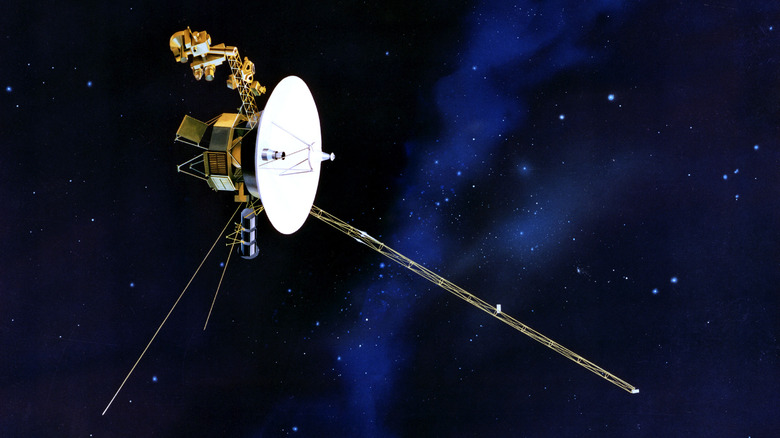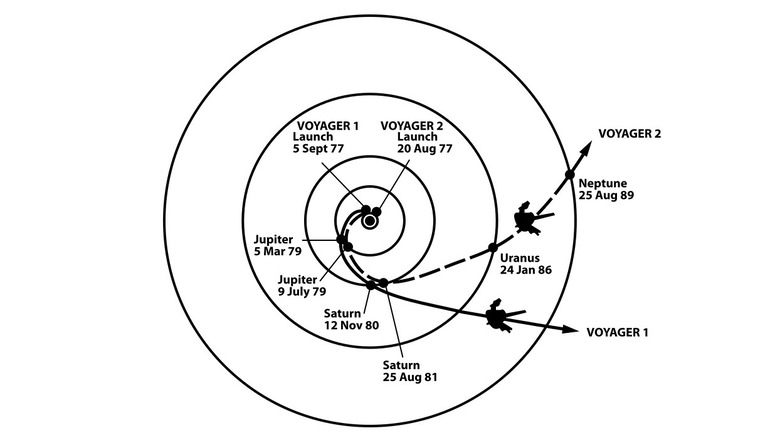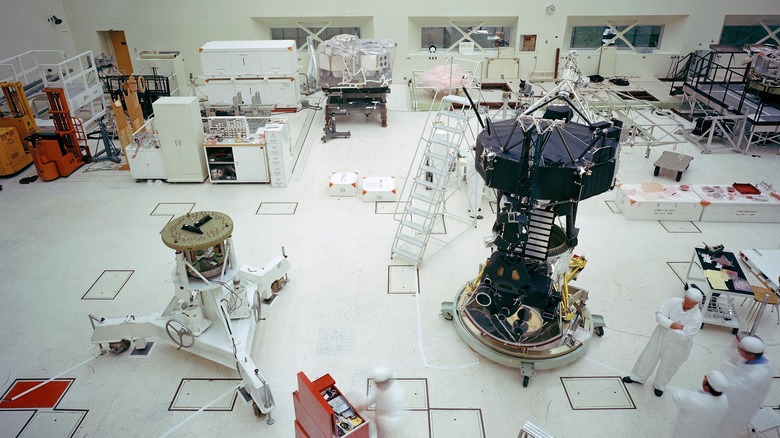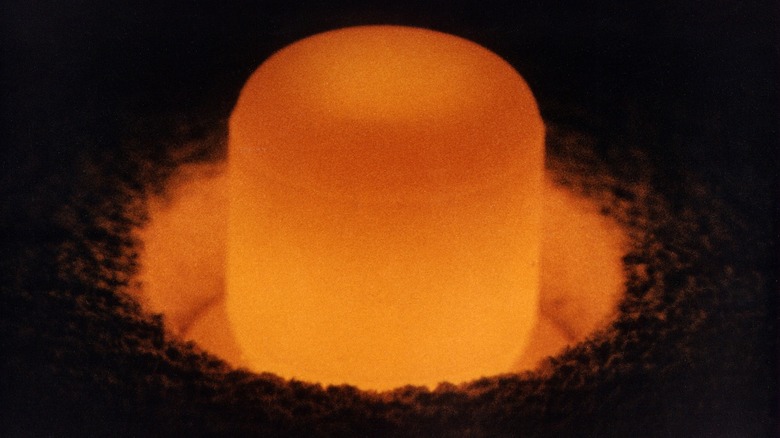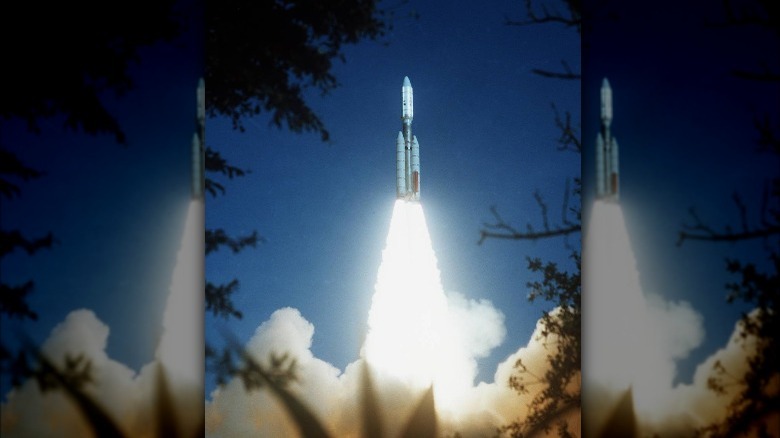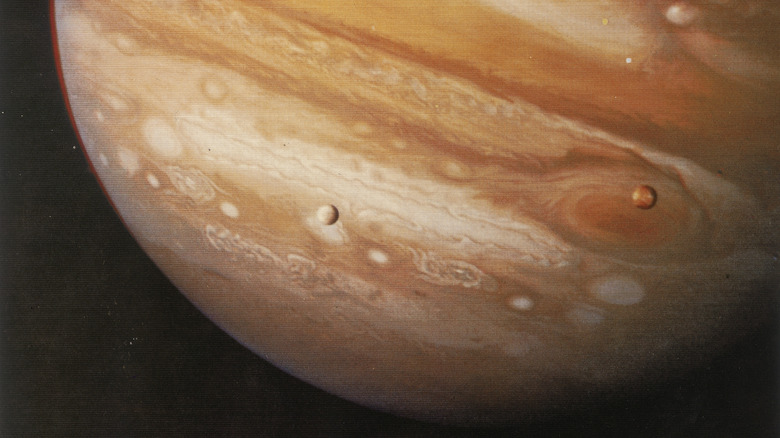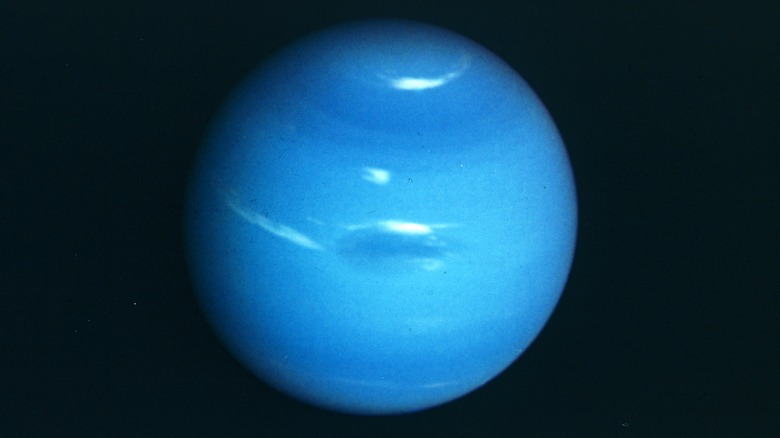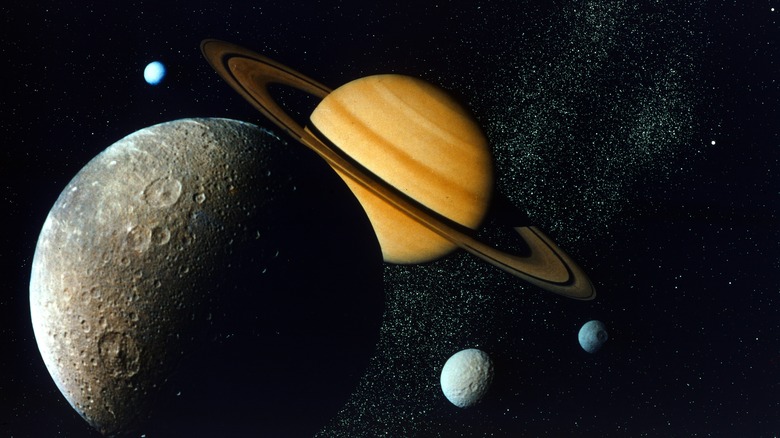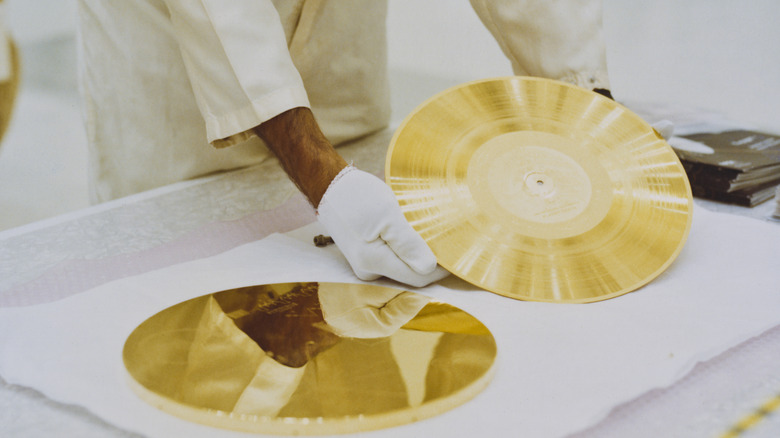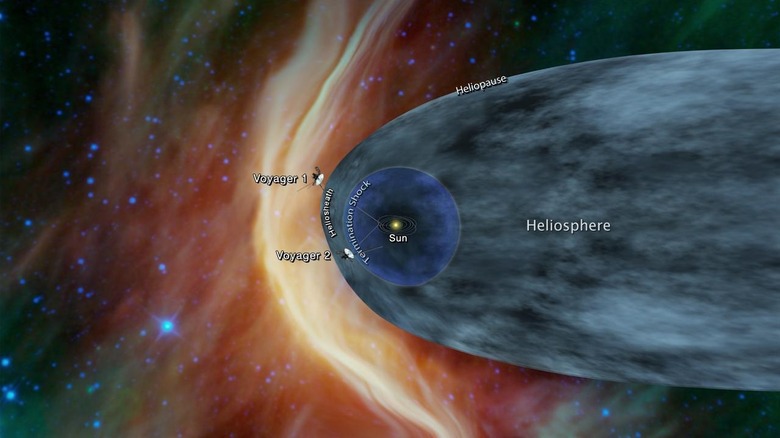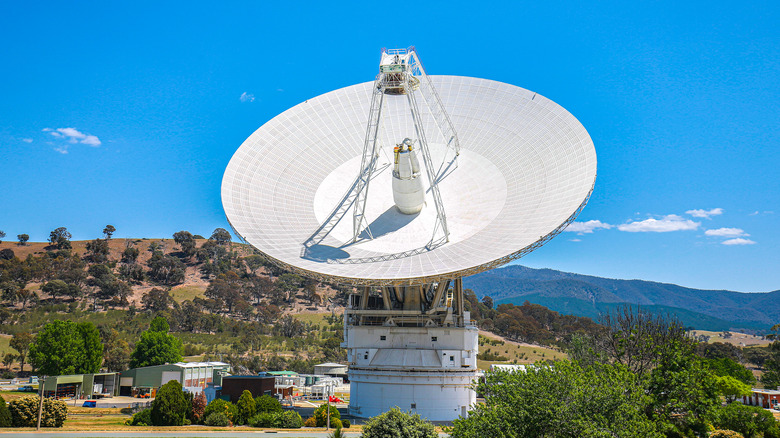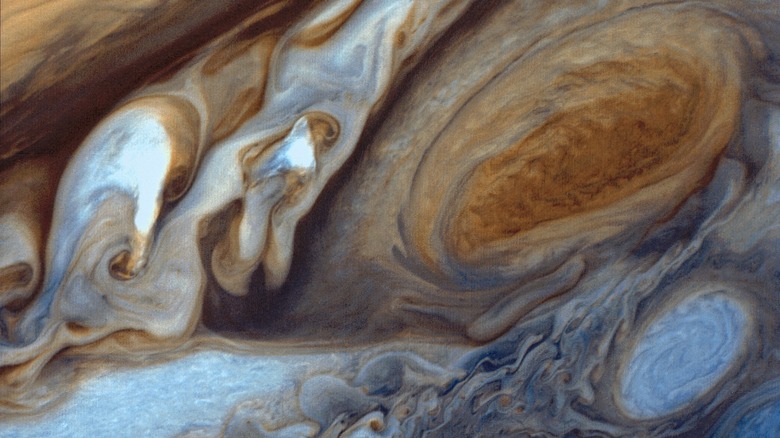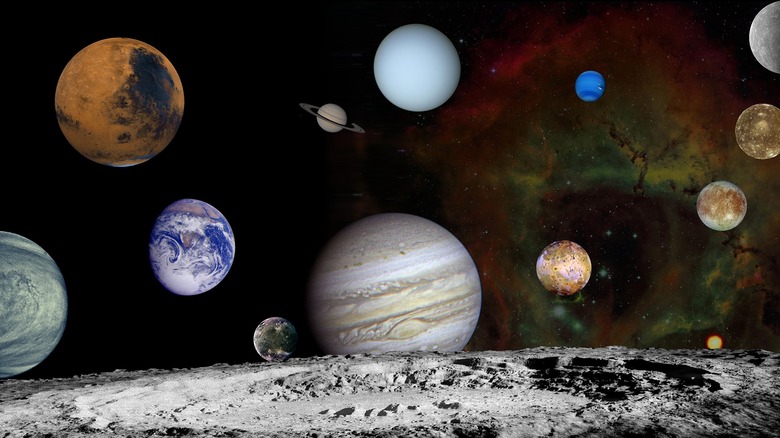The Untold Truth Of The Voyager Program
In 1979, Paramount Pictures released "Star Trek: The Motion Picture." In this first big-screen outing of the "Star Trek" franchise, IMDb tells us that the crew of the Enterprise face off against an enormous alien spacecraft called V'ger, a living machine. In the climax, it is discovered that V'ger is none other than Voyager 6, a probe from the famed 20th-century Voyager missions.
While in truth there was no Voyager 6, there indeed was and is a Voyager program. This program was born in the mid-20th-century space race, which NASA states culminated in the 1969 moon landing. While the moon landing was a major feat, it can be argued that we have learned more about our solar system and beyond through the Voyager program.
The concept of the mission was straightforward: Launch two spacecraft into our solar system to explore the outer planets. These probes left Earth in 1977, and not only did they achieve their mission, they have gone well beyond it, still transmitting data into the 2020s. Let's explore the details of the truth behind one of NASA's most successful space programs.
Voyager was only possible because of a 176-year phenomenon
The concept of the Voyager program was a natural addendum to the Mariner program. The Mariner space probes, as Britannica relates, were sent to the inner planets of our solar system — Mercury, Venus, and Mars — starting in 1962. Voyager was a similar concept, but its sights were set in the opposite direction. Yet the challenge here was the vast distance involved in reaching the outer planets. However, NASA's Jet Propulsion Laboratory tells us that in the summer of 1965, scientists had an epiphany. They found that once every 176 years, the giant planets of the outer solar system were aligned in such a way that it would be feasible to for a spacecraft to visit all of them by swinging from one to the other like a gymnast on the uneven bars. The secret to doing this was that the probes would be able to capitalize on the intense gravity of each planet to slingshot them on to the next. Futurism points out this trick allowed the Voyager probes to conserve precious fuel. It also greatly reduced the trip time. Without the gravity assist, a trip to Neptune could take 30 years; for Voyager, this dropped to 12. Thus, thanks to planetary alignment and more than a little gravity, NASA's Voyager program became a grand tour of the outer solar system.
There is no discernable difference between Voyager 1 and Voyager 2
For the grand tour, NASA designed two spacecraft: Voyager 1 and Voyager 2. One might assume that Voyager 2 is a more advanced vessel — like the numbers denoting a computer's operating system. However, according to NASA's Jet Propulsion Laboratory, the truth is that these two space probes are identical twins with all the same 65,000 parts.
The most prominent feature on the Voyagers are the over 12-foot-diameter radio dishes that transmit data to and receive commands from NASA. This dish is mounted on a nearly 6−foot-wide bus shaped like a decahedron. The Voyagers' other obvious features are three booms. There is an over 8−foot science boom that extends out from the spacecraft. This contains most of the scientific instruments for the mission, which include imaging equipment, particle detectors, and plasma sensors. More noticeable is Voyagers' second boom, a nearly 43−foot magnetometer. This instrument is used to measure changes in the magnetic field of the sun over distances, as well as to detect if the planets the probes were visiting had magnetic fields and, if so, how those planets' satellites interacted with them. The third boom extends out and contains the Radioisotope Thermoelectric Generators (RTG). These provide electrical power to keep the mission going. Both spacecraft are surprisingly light — both Voyager 1 and Voyager 2 weigh 1,592 pounds — but they are highly complex. It is remarkable that neither has experienced a major malfunction over the decades.
Voyager is powered by an extremely rare element
The Voyager probes were sent on a very long-distance trip with no place to refuel. NASA needed to find a power source that would allow the probes' RTGs to operate for decades. They found the answer in plutonium-238 oxide. Hearing the word "plutonium," one may think this is the same stuff that is used in nuclear weapons — think "Back to the Future." However, the truth is that this variation of plutonium would not work well in either a missile or a nuclear power plant. Plutonium-238 emits alpha particles that heat the RTG's container, and that heat is then converted to electricity. Plutonium-238 has the virtues of having a long half life of 88 years, being stable despite high heat, and being able to generate more heat relative to its weight than other types of fuel. It also has a relatively low level of radiation, which is important since you don't want to have radiation interfere with Voyagers' instruments.
The element is also very rare. As the EPA explains, plutonium rarely exists in nature, and everything that NASA has is human-made. As for plutonium-238, production of the element has only been renewed in recent years, according to NASA. It is considered the only effective fuel for deep-space missions. For Voyager, this means an incredible fuel efficiency of 30,000 miles per gallon since most of its rocket fuel was burned right at launch.
Voyager 2 left before Voyager 1
By 1977, NASA was ready to launch Voyager 1 and Voyager 2. Curiously, the space agency launched Voyager 2 first on August 20. Voyager 1 followed about two weeks later on September 5. To get the probes into space, NASA perched them atop expendable Titan-Centaur rockets. The Air and Space Museum notes that in truth, each Titan-Centaur unit consisted of multiple rockets that fired in stages to overcome Earth's gravity and operated with a mix of liquid and solid fuel. At the time of the "flawless" launch of Voyager 1, The New York Times commented that scientists expected that the Voyager spacecraft could last for 30 years. These scientists underestimated their own spacecraft.
Even though Voyager 2 launched first, Voyager 1 traveled faster using a shorter trajectory. It was still a long journey. Voyager 1 arrived at Jupiter on March 5, 1979, and Voyager 2 on July 9 of that year.
Voyager gave us our first close-ups of the gas giants
What NASA originally had planned for the Voyager spacecraft was an exploration trip to Jupiter and Saturn. This was highly successful. In its flyby of Jupiter, Voyager 1 also examined several of its moons and made strange discoveries, such as the intense volcanism on the moon Io, as well as finding two new moons. Using a camera that could make out a newspaper headline at .62 miles, it sent back photographs of the landscapes of these moons and opened up new paths in planetary science. Similar discoveries were made when the spacecraft reached Saturn in November 1979, where it found new moons and made a detailed study of Saturn's ring system. Voyager 2 was equally successful and made even closer approaches than Voyager 1. In fact, Voyager 2 flew through Saturn's rings at 8 miles per second, during which time thousands of tiny dust fragments bombarded the spacecraft, forcing it to use its attitude control thrusters to keep it on course. Curiously, Voyagers' thrusters are not exactly like the thrusters on, say, a Battlestar Galactica Viper. NASA's Jet Propulsion Laboratory tells us that a Voyager thruster only provides a thrust of 3 ounces. While this is okay in frictionless space, if a large car were using these thrusters to accelerate on a flat road, NASA says it would take 6 hours to reach a speed of 30 miles per hour.
Voyager 1 and 2 have separate fates
After Saturn, the twin spacecraft went on to different destinies. The Planetary Society recounts how Voyager 1 veered off of the plane of the solar system and headed for interstellar space. Voyager 2, however, headed toward the deepest planets of the solar system. It reached Uranus in January 1986, where it discovered two unknown rings and 11 moons. As NASA's Jet Propulsion Laboratory describes, Neptune was equally fruitful, with amazing data and images. After reaching it in 1989, Voyager 2 came within 3,000 miles of this planet, discovering six unknown moons and four rings.
The truth is that there were particular challenges with Neptune. NASA explains that this planet is 30 times farther away from the sun than Earth. As a result, the light is faint. In order to get images, Voyager 2 had to use long exposure times for its cameras. However, since the probe was moving so fast (about 60,000 mph at the time), NASA had to direct the spacecraft to fire its thrusters to coax the probe's cameras to stay focused on the planet while not altering its course.
After Neptune, Voyager 2 joined Voyager 1 in heading to interstellar space. The Planetary Society says that Voyager 1 reached the heliopause, the point where the solar wind ceases, in August 2012. Voyager 2 entered it in November 2018. This showed scientists about where the solar system ends and also provided information on what makes up interstellar space.
Voyager went well beyond its mission
Perhaps what is most remarkable about the Voyager program is the endurance of these spacecraft. Much of the credit for this goes to the clever NASA scientists and engineers who figured out ways to keep the little probes chugging along. Universe Today notes that to deal with inevitable energy loss, systems have been shut down one by one. Sometimes things work out better than expected. In 2011, NASA shut off the heater for Voyager 1's ultraviolet spectrometer to conserve fuel. The instrument was designed to operate down to minus 31 degrees F, but they found that it kept working down to minus 110 degrees F. Similarly, they found that the Cosmic Ray Subsystem will operate at temperatures of minus 74 degrees F, although they were tested only down to minus 49 degrees F. In 2017, NASA noticed a problem with one of Voyager 1's thrusters, which needed to operate properly to orient its dish toward Earth. They started up a secondary thruster which had not been operated for 37 years. Amazingly, it worked fine. Suzanne Dodd, the Voyager Project Manager with NASA's Jet Propulsion Laboratory, stated, "It's incredible that Voyagers' instruments have proved so hardy."
Both Voyager 1 and 2 are still active, with NASA reporting their status in real time. Inevitably, the Voyagers will run out of fuel and cease communication with us on Earth. The Jet Propulsion Laboratory estimates that they will function until at least 2025. However, both of these spacecraft carry a message from us to others who may be among the stars.
Voyager's golden records highlight whale song
Even though the Voyager probes' signals to us will eventually fade to nothing, the spacecraft will continue to travel through space indefinitely. The Jet Propulsion Laboratory estimates that with their current course and speed, they will approach neighboring stars in about 40,000 years. This is why each Voyager carries a golden record. As reported by Smithsonian Magazine, the record is the brainchild of astronomers Carl Sagan and Frank Drake. They had already sent on the Pioneer 10 and 11 spacecraft gold-anodized aluminum plaques that featured etched images of a man and woman with directions to Earth. Hopefully, if any alien race found these plaques, they would come in peace.
The records carried by the Voyagers, however, are different since they contain the sounds and sights of Earth. On it are 115 encoded photographs, 90 minutes of music, salutations in 55 languages, and 12 minutes of Earth sounds. Some information is human-specific, such as showing human reproductive anatomy as well as the structure of our DNA. They also show humans eating and drinking and include excerpts from Euclid and Isaac Newton. Animal sounds were added as well, including a haunting whale song. It is assumed that if any extraterrestrial civilization finds the golden records, they will have the technology to decode them. Whether it would make sense to them remains to be seen.
Voyager is not the fastest, but the farthest
Because of the gravity-assisted slingshot effect the Voyagers received during their mission, they have built up to an incredible speed. NASA's current mission status shows Voyager 1 traveling in excess of 38,000 miles per hour while Voyager 2 is cruising along at a not-too-shabby 34,000 miles per hour. This makes them among the fastest-traveling human-made space objects out there.
However, it is necessary to put this into perspective since there are some probes out there that have achieved many times the speed of the Voyager spacecraft. The current record holder is the Parker Solar Probe. CNET reported that in 2021, this spacecraft achieved an unfathomable speed of 330,000 miles per hour after it slingshotted around Venus and entered a close orbit with the sun. So while Voyager wouldn't get the gold medal in a 100-meter dash, it would win a marathon. At over 14 billion and 12 billion miles away from Earth respectively, Voyagers 1 and 2 are the most distant human-made objects from Earth, according to Earth Sky. Keep in mind, however, that in the grand scheme of things, 14 billion miles is peanuts. To get to even a close star, NASA says it will take millennia upon millennia. For example, in 296,000 thousand years, Voyager 2 will get within 4.3 light years of Sirius, the brightest star out there.
Only one place on Earth can communicate with Voyager 2
Considering the growing distance that separates the Voyager spacecraft from Earth, communications have been a challenge that has only grown more complicated through the years. In 2022, NASA noted that it takes over 20 and a half hours to send a signal to Voyager 1. In its primer on Voyager communications, How Stuff Works explains that the probes use 23-watt radios, which on the whole are not nearly as powerful as, say, a commercial radio station, which transmits at tens of thousands of watts. To do the job, Voyager and Earth point their signals directly at each other and use very large antennas. What is more, communications are sent at 8 GHz — a rarely used frequency — thus there is less interference. With all these specific requirements, it is little wonder that, according to NASA, there is only one place remaining on the globe that can communicate with Voyager 2: Deep Space Station 43 (DSS43). This station, which is in Canberra, Australia, is part of the Deep Space Network, an assortment of antennas around the world that communicates with spacecraft beyond the moon. In order to improve its deep-space communication abilities, DSS43's antenna was upgraded to a 230-foot-wide dish in 1987.
The Voyager program has a great return on investment
The Voyager program is perhaps one of the single best returns on investment in the history of NASA. From the time work started on it in 1972 until its encounter with Neptune, Voyager cost $865 million dollars. This figure includes all ancillary communication support. NASA points out that this figure would mean a burden of 8 cents per U.S. resident per year. This is not to say that Voyager was cheaply done. NASA put in 11,000 work years on the project until the Neptune flyby, which they compare as being one third of the amount of effort expended on constructing the Great Pyramid.
The truth is that stacking up the Voyager program to a world wonder is an apt comparison. The amount of data and information that we have received (five trillion bits worth) has expanded our horizons (literally) and knowledge of ourselves and our small planet's place in the universe.
Voyager may outlast humanity
If you were to make a bet on which will last longer, Voyager or humankind, the odds may just favor Voyager. Space.com considers the mission's longevity. It notes that one projection shows that with the spacecraft's current trajectory, after some 500 million years, the probes will have completed an orbit of the Milky Way. By this time, Voyager 1 will be above the plane of the galaxy, which means that it will see fewer stars than Voyager 2 since it will be in a much less dense region.
The greatest danger to the Voyagers is space dust, which, when moving at several miles per second, could flay away the skin of the spacecraft like a cosmic sandblaster. It is unlikely that the Voyagers will get close enough to a star to truly endanger them for billions of years. In fact, it may be an as-yet unborn star that finally takes out one of these dogged spacecraft. So while its far-future course is hard to predict, it may be that Voyager 1 and 2 will at least be flying at the time that the Andromeda galaxy collides with the Milky Way, which will be in five billion years, according to Earth Sky. And if all goes well, Voyagers' golden records could theoretically last just as long – longer than life on Earth, in fact. In this way, the Voyagers would become eternal artifacts of a human civilization that once existed on a small blue world.
